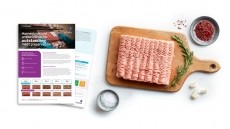Mint additive could extend shelf life of meat products
tables, and could become even more closely linked after new
research has reported that the herb spares the meat from the
detrimental effects of irradiation.
Interest is growing in plant-derived food additives as replacements to synthetic antioxidants like butylhydroxyanisole (BHA) and butylhydroxytoluene (BHT) to slow down the oxidative deterioration of food.
Indeed, according to a 2003 report by Frost and Sullivan, the synthetic antioxidant market is in decline, while natural antioxidants, such as herb extracts (particularly rosemary), tocopherols (vitamin E) and ascorbates (vitamin C) are growing, pushed by easier consumer acceptance and legal requirements for market access.
But while interest in natural sources is increasing, the authors of the new study, from Food Technology Division at the Bhabha Atomic Research Centre in India, report that the potential antioxidant properties of mint have not been well studied, and its application in meat has not been studied at all.
The research, published in the journal Food Chemistry (Vol. 100, pp. 451-458), indicates that a mint extract could be a cost-effective additive for irradiated lamb meat.
The process of irradiation entails exposing foods to ionizing radiation that kills insects, moulds and bacterium. The technology, which can kill up to 99 per cent of pathogens, is seen by the industry as a means of ensuring food safety.
While food irradiation is slowly gaining consumer acceptance in the US and several other countries, the technology has been slow to get support within many parts of Europe, including the UK, where the Food Standards Agency (FSA) recommends no extension of its application from current permitted uses.
The process can is also known to speed up the peroxidation of lipids in the meat, which can adversely affect flavour, colour, texture and the nutritional value of meat.
"Addition of mint extract to irradiated lamb meat may be able to prevent lipid peroxidation, in addition to imparting flavour and taste to the meat. This combination treatment could have an important economic impact as it might reduce losses attributed to spoilage and also allow the products to reach new and distant markets," wrote lead author Sweetie Kanatt.
Kanatt and co-workers measured the total phenolic content of the mint extract at 25.62 mg in terms of catechin equivalent/g of wet weight, with a corresponding flavonoid content of 13.5 mg per gram.
Antioxidant activity and radical scavenging activity were measured using the DPPH (1,1-diphenyl-2-picrylhydrazyl) assay, as well as the hydroxyl radical scavenging and superoxide anion-scavenging tests, and compared to BHT.
The Mumbai-based researchers report: "The antioxidant activity of ME was found to be comparable to the synthetic antioxidant, butylated hydroxytoluene (BHT)."
When used as an additive in a sample of radiation-processed lamb meat, the researchers report that the Thiobarbituric acid-reactive substances (TBARS) produced from lipid peroxidation values of mint extract meat sample stored for four weeks was 50 per cent that of the untreated irradiated meat.
Even after heat processing the antioxidant activity of the mint extract-irradiated meat sample was still evident.
"In the case of spices, such as garlic, ginger, cloves, basil and pepper, it has also been reported that heating at 100 degrees Celsius or above did not result in any loss of antioxidant activity," said the researchers.




























